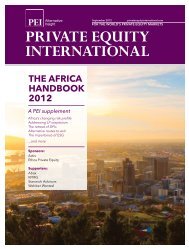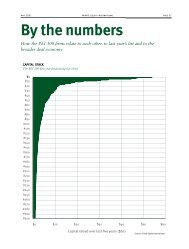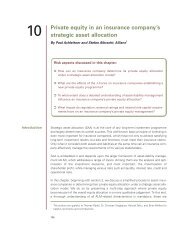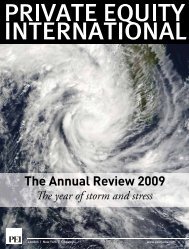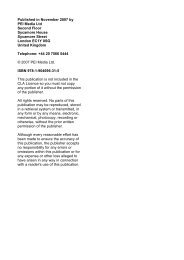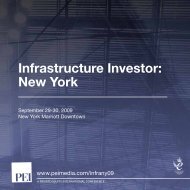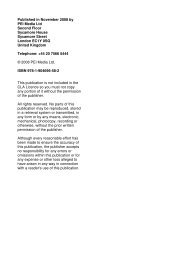INSTITUTIONAL INVESTOR SENTIMENT SURVEy - PEI Media
INSTITUTIONAL INVESTOR SENTIMENT SURVEy - PEI Media
INSTITUTIONAL INVESTOR SENTIMENT SURVEy - PEI Media
Create successful ePaper yourself
Turn your PDF publications into a flip-book with our unique Google optimized e-Paper software.
Private equity is<br />
coming under<br />
increased<br />
scrutiny<br />
institutional<br />
investor<br />
sentiment<br />
survey<br />
foreword<br />
executive summary<br />
allocation<br />
fees<br />
lp – gp relationship<br />
future investments<br />
•<br />
and concerns<br />
appendix: global<br />
fundraising<br />
page 36<br />
ensuring improved reporting standards. In addition, a number of states are reconsidering<br />
their pension funds’ involvement in the asset class, with some even calling for public<br />
pension funds to pull out of the asset class altogether.<br />
A combination of events has culminated in a perfect storm which may lead to a shakeout<br />
in the industry. A number of issues which are likely to have a major impact on the industry<br />
in 2012 include:<br />
1. The rise of separate accounts – many major US pension funds have already taken action<br />
and set up separate accounts with well-known GPs, with many more following suit by<br />
preparing proposals for board approval. There is a general focus on more customised<br />
investment solutions, such as co-investments, which not only allow greater control<br />
over portfolio acquisitions, but also give LPs greater exposure and negotiating power<br />
when it comes to deciding fund terms, such as management fees and carry.<br />
2. Consolidation of investments – LPs are keen to consolidate their investments with a<br />
few trusted fund managers, rather than spreading their allocation across a number of<br />
GPs. LPs with a number of existing GP relationships are streamlining their portfolio<br />
through selling interests on the secondaries market. Although LPs are seeking fewer<br />
GP relationships, they continue to maintain, or increase, their allocation to the asset<br />
class which leads to larger accounts with each of their GPs.<br />
3. Active secondaries market – LPs are actively selling their interest in funds on the<br />
secondaries market in order to free up capital and ensure vintage year diversification<br />
in their portfolios. One prominent example is that of the Government of Singapore<br />
Corporation who have, for the first time, hired an intermediary to handle the process<br />
of selling over $700 million of fund interests.<br />
4. Shift in power in the LP-GP relationship – LPs are not only forging closer bonds with<br />
GPs, they are also creating dialogue with fellow LPs in order to build up their negotiating<br />
power when it comes to discussing fund terms and arranging fund extensions.<br />
With more LPs committing more capital to fewer GPs, the amount managed by each<br />
GP is certain to increase which will also allow LPs to have more negotiating power.<br />
5. Change in GP fee structure – LPs have recently started demanding a change in the<br />
traditional fee structure imposed by GPs. This ranges from paying management fees<br />
on invested capital (rather than committed capital) to favouring customised accounts<br />
which come with more favourable fees. Although larger firms are able to negotiate and<br />
offer better deals to their LPs, smaller GPs will struggle to compete with them.<br />
www.privateequityconnect.com




